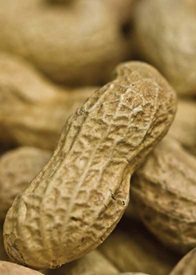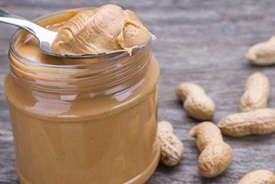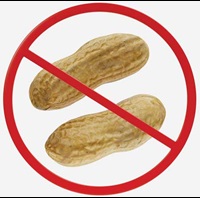Peanuts: Earth’s Shelled Wonders
FOOD SAFETY AND QUALITY

Astronaut Alan Shepard, commander of Apollo 14, took a peanut from a restaurant with him to the moon in January 1971, then brought it back as a gift for the restaurant owner. Peanuts do much more than go to the moon: They are a versatile food, consumed as snack nuts, peanut butter, ingredients in confectionery and baked goods, cooking oil, and a nutrient-dense food with essential nutrients, vitamins, and bioactive compounds that can deliver important health benefits, from improving circulation to helping ward off diseases.
History and Types
The peanut originated in South America around 8,000 B.C. Researchers mapping the peanut genome have found that peanuts 10,000 years ago had simpler (diploid) genomes and that about 8,000 years ago the ancestral parents crossed and formed today’s more-complex (tetraploid) peanut. The United States is the world’s third largest producer of peanuts, after China and India, producing up to three million tons a year. Eleven states account for most of the peanuts grown in the United States, with Georgia providing half and Texas, Alabama, Florida, North Carolina, South Carolina, and others providing the rest. Four basic types of peanuts are produced in the United States, differing in flavor, oil content, size, shape, and disease resistance:
• Runner peanuts constitute 80% of total U.S. peanut production. The kernels are small to medium in size and somewhat elongated, many with flattened ends. They contain two kernels per pod and are used primarily to manufacture peanut butter.
• Virginia peanuts account for about 15% of U.S. peanut production. The pods are large and generally contain two medium-to-large, generally elongated kernels. They are marketed mainly as snack peanuts.
• Spanish peanuts make up 4% of U.S. peanut production. The pods contain two small-to-medium kernels that are rounder and have a higher oil content than other types. They are used for snack peanuts, peanut butter, and confectionery.
• Valencia peanuts account for less than 1% of U.S. production They usually have two to four kernels in long cylindrical shells. The kernels are small to medium with flattened ends and are marketed mostly in the shell for roasting and boiling.
 From the Farm to the Processor
From the Farm to the Processor
Peanuts are the seeds of an annual plant that grows above ground and produces its fruit below the ground, which is why they are also called groundnuts. The seeds grow into plants about 18 inches tall that develop yellow flowers. The flowers pollinate themselves and lose their petals as the fertilized ovary (peg) begins to grow. The peg grows downward from the plant into the soil, spreads out horizontally, and begins to mature into a peanut kernel surrounded by a thin red skin in a pod (shell).
When about 70% of the pods have reached maturity in four to five months, a machine called a digger cuts the taproot below the soil; then a machine called a shaker/inverter lifts the plant, shakes off the soil, and turns the plant over to expose it to the sun. After the pods have dried in the field for up to three days to a moisture content of 20%–25%, a machine called a combine or thresher separates the pods from the vines. The pods are placed into drying wagons, where forced hot air reduces the moisture content to 8%–10%. Next, the pods are cleaned to remove dirt, rocks, sticks, and other foreign material, and the resulting product, referred to as farmers stock, is transported to buying stations for grading and sale. All peanuts marketed in the United States are inspected and graded by the Agricultural Marketing Service (AMS) of the U.S. Dept. of Agriculture (USDA) or federally licensed state inspectors. The USDA consults with the Peanut Standards Board on quality standards for domestically produced and imported peanuts and provides guidelines for their inspection and certification.
During inspection, a pneumatic sampler withdraws a representative sample from the farmers stock, and an inspector determines the kernel weight, size of pods, percentage of damaged kernels and foreign material, and kernel moisture content. The peanuts are removed from their shells before moisture content is determined; if it is too high, the corresponding lot of peanuts requires further drying. The farmers stock is also checked for the presence of mold. The farmers stock peanuts are either stored in 7,000- to 10,000-ton controlled-moisture warehouses at the buying station or transported directly to shelling plants in open-top semi-truck trailers.
At the shelling plant, the pods are cleaned to remove any foreign material, then conveyed to shelling machines, where they are forced through perforated grates to remove the shells. The kernels are separated from the shells by forced air; then specific-gravity machines separate the kernels and the unshelled pods. The kernels then pass over perforated screens to sort them by size into market grades. Split kernels are separated from whole kernels by sizing screens. High-speed optical sorters eliminate discolored or defective kernels and any remaining foreign material. The peanuts are then graded by AMS inspectors and checked for aflatoxin; upon purchaser request, additional testing is performed. The peanuts are packaged in one-ton tote bags for transport to the purchaser’s plant for further processing into various products. If raw peanuts are held for more than two weeks, they are moved to storage areas kept at 38°F–55°F. Blanchers remove the red skins from the kernels if requested by the product manufacturer prior to shipment.
 Consumed in Many Forms
Consumed in Many Forms
Peanuts are consumed in a variety of ways: Peanut butter accounts for a little more than 50% of the U.S. consumption of peanuts. Made from ground dry-roasted peanuts, peanut butter must contain no less than 90% peanuts. The product is marketed in creamy and chunky versions, the latter containing peanut pieces. Most peanut butter is stabilized so the oil doesn’t separate out. Reduced-fat peanut butters are also available, as are other modified formulations such as peanut spreads and peanut paste.
Peanut oil constitutes about 15% of the U.S. production of peanuts. It has a mild flavor, a relatively high smoke point, and a high content of monounsaturated fat and is resistant to rancidity. The oil is extracted from shelled and crushed peanuts by hydraulic pressing, expeller pressing, and/or solvent extraction. Since the oil is highly refined, the protein has been removed, and persons allergic to peanut protein can consume it. However, cold-pressed peanut oil such as Oliver Farms’ Green Peanut Oil and premium roasted peanut oil are not highly refined and can still contain peanut protein.
Peanut flour accounts for less than 2% of the U.S. production of peanuts. It is low in fat, high in protein, and gluten-free and made from blanched peanuts that have been roasted and pressed to reduce the fat content. Peanuts for snacking are sold shelled and in the shell and make up about 15% of the U.S. production of peanuts. Shelled peanuts are marketed roasted or dry roasted with various seasonings and coatings. Most in-shell peanuts are Virginia peanuts and are generally sold salted. And peanut milk is being marketed by Elmhurst Milked, under the brand name Milked Peanuts. It is a nondairy milk made from runner peanuts in a cold-milling process.
Aflatoxin Testing and Research
The fungus Aspergillus flavus is one of several molds that can contaminate peanut kernels in the field and during storage. Because these molds have the potential to produce a toxic and carcinogenic metabolite called aflatoxin, the peanut industry and the USDA inspect every lot of raw peanuts, and any containing aflatoxin levels that exceed the federally mandated limit are either destroyed, reprocessed, blanched, or crushed for oil. Those that are reprocessed or blanched must be re-inspected.
USDA inspectors first examine the farmers stock of raw peanuts for evidence of mold contamination. If mold is observed on the shell and/or kernel, an assay must be performed to determine possible aflatoxin contamination. The aflatoxin limit for domestic and imported peanuts is 15 parts per billion (ppb). The AMS performs aflatoxin assays on peanut kernels using official methods of analysis; certifies lots as negative if the level is no higher than 15 ppb; and provides the U.S. Food and Drug Administration (FDA) with a summary of analyses completed each quarter, including the number of lots examined, the number containing aflatoxins, range of levels, and the identity of each lot containing aflatoxins.
The FDA directs its activities regarding aflatoxin toward products intended for direct consumption, not raw peanuts. The agency considers that an aflatoxin level of up to 20 ppb is not expected to result in adulteration because current good manufacturing practices remove significant quantities of unfit peanuts and levels of total aflatoxins are reduced by heating.
More than a decade ago, the National Peanut Research Laboratory (NPRL) of the USDA’s Agricultural Research Service (ARS) developed a method of biological control of aflatoxin contamination by use of a naturally occurring A. flavus strain that does not produce aflatoxin. The product was successful in reducing field aflatoxin levels, and Syngenta Corp. markets it as Afla-Guard biofungicide.
The NPRL recently completed a five-year project that began in July 2013 to identify useful genes for breeding high-yielding peanut varieties. Among accomplishments reported in the NPRL’s 2017 annual report, researchers identified the predominant genotypes of aflatoxigenic Aspergillus that colonize peanut seeds, identified and sequenced the whole genome of the most frequent genotypes, and targeted genome sequences for silencing through ribonucleic acid interference technology to control aflatoxins; this treatment resulted in 70%–100% reduction in aflatoxin. The NPRL also began a five-year research project in July 2015 on postharvest systems to assess and preserve peanut quality and safety. Among the accomplishments reported in its 2017 annual report was a determination that shelled peanuts could be stored at up to 55˚F without significant changes in peanut quality and mold growth.
Scientists at the Donald Danforth Plant Science Center and their collaborators at the International Crops Research Institute for the Semi-Arid Tropics, the USDA, and Louisiana State University reported in Plant Biotechnology Journal in October 2017 that they developed a strategy to create peanut germplasm with improved genetic resistance to A. flavus infection and aflatoxin contamination. Transfer of small proteins called defensins from alfalfa and Mediterranean clover to the DNA of an Aspergillus-susceptible peanut variety widely grown in Africa and India allowed the peanut to prevent the fungus from infecting the plant.
 Peanut Allergy
Peanut Allergy
Peanut is one of the eight major food allergens in the United States. According to a 2017 study published in Annals of Allergy, Asthma & Immunology, more than 1.7 million children in the United States are estimated to be allergic to peanuts. Peanut allergy results from a specific immune response to exposure to peanut protein. Symptoms range from hives, swelling, respiratory difficulty, cardiovascular compromise, and gastrointestinal issues to potentially fatal anaphylaxis. Strict avoidance of peanuts is the primary strategy to prevent anaphylaxis, but total avoidance is not always possible because food products may contain the peanut protein allergen in small amounts due to cross-contact in processing plants. The FDA requires the potential presence of peanut and other major food allergens in food products to be indicated on the product label.
Sixteen allergenic proteins have been identified in peanuts, and an April 2018 article in Molecular Immunology reviewed what is known about them and how purified allergen molecules are used in diagnostic multiplex protein arrays to detect the presence of allergen-specific antibody Immunoglobulin E. And researchers at Mount Sinai Health System reported in Nature Communications in December 2017 that they have identified six genes that activate hundreds of other genes in children who experience severe allergic reactions to peanuts. They studied gene expression in children before, during, and after an oral food challenge with peanut. RNA sequencing on blood samples determined which genes caused the allergic reactions.
A variety of allergy treatments are being explored to desensitize people to peanut protein. They include introducing incrementally increasing doses of peanut protein by mouth (oral immunotherapy) or through a skin patch to desensitize peanut-allergic individuals over time and induce the immune system to tolerate peanuts. Numerous clinical studies are being conducted to determine the effects of various treatments on peanut allergy in children and adults. The U.S. National Library of Medicine provides a database of clinical studies conducted around the world.
In one approach, Aimmune Therapeutics is in the final stages of clinical testing to support regulatory approval for use of its investigational drug AR101 for desensitization of peanut-allergic patients aged 4–17. The peanut-powder drug comes in a capsule that the user would break open and sprinkle over foods such as applesauce or pudding. The user would take increasing amounts of the powder daily to build up a tolerance over six months, then take 300 mg every day thereafter to maintain desensitization. The company is scheduled to submit an application to the FDA for approval around the end of 2018. In another approach, DBV Technologies has been conducting clinical trials in children aged 1–11 to assess the safety and efficacy of its Viaskin Peanut skin patch in activating the immune system.
The LEAP (Learning Early About Peanut allergy) clinical study, conducted by the Immune Tolerant Network and sponsored by the National Institute of Allergy and Infectious Diseases, demonstrated that regular peanut consumption begun in early infancy and continued until age 5 reduced the rate of peanut allergy in high-risk infants by up to 86%; the results were published in the New England Journal of Medicine in February 2015. A follow-up study, LEAP-ON (Persistence of Oral Tolerance to Peanut), published in April 2016, showed that the peanut allergy prevention persists after a one-year period of avoiding peanut.
Researchers in England reported in Journal of Allergy and Clinical Immunology in May 2018 that they have developed a blood test called the Mast Activation Test to diagnose peanut allergies that has a 98% accuracy rate and cuts the risk of false-positives. And ARS researchers at the USDA’s Southern Regional Research Center described in Food Science and Nutrition in July 2017 methods that could be used to develop less-allergenic peanut extracts that could potentially be used during immunotherapy. Earlier, ARS researchers had shown that raw peanut proteins undergo specific molecular changes during roasting that alter their allergenic properties.
 Neil H. Mermelstein,
Neil H. Mermelstein,
IFT Fellow,
Editor Emeritus of Food Technology
[email protected]


